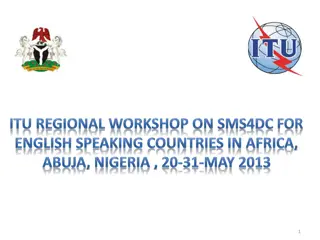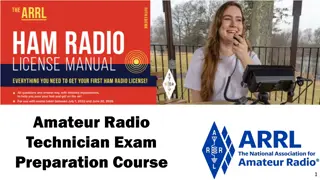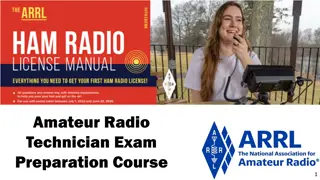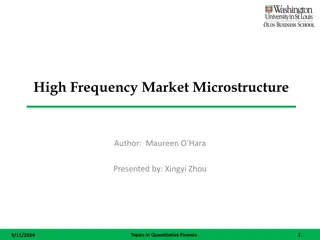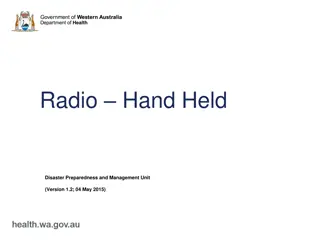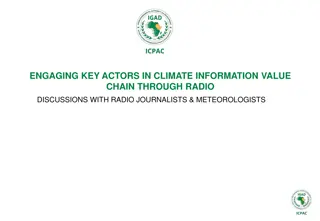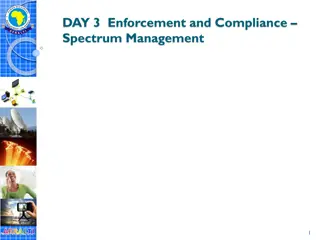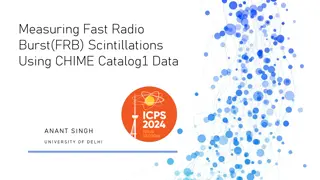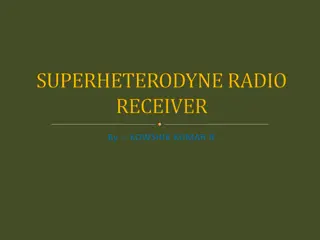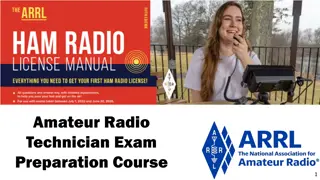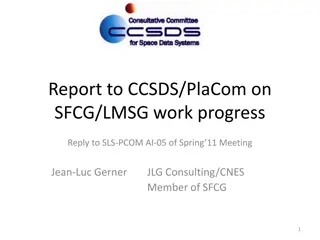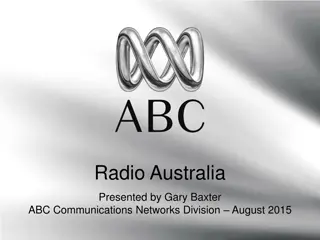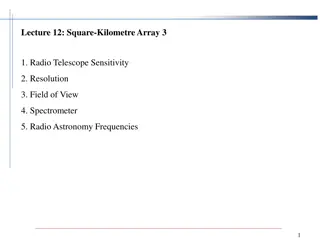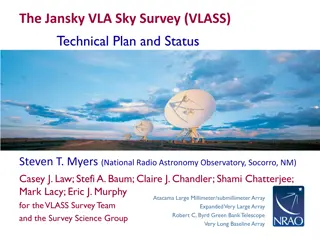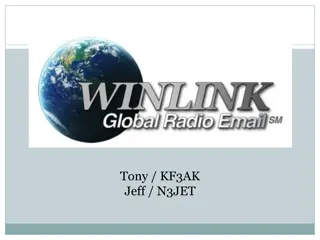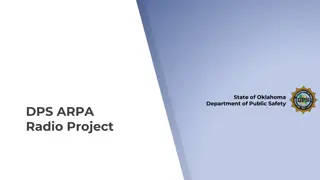Understanding High Frequency Radio Communications and ALE
High Frequency (HF) radio communications, specifically using Single Side Band (SSB) modulation, are essential for effective long-distance communication. The components of an HF radio system include a transceiver, antenna, and power source. By utilizing the ionosphere, HF/SSB modulation enables cost-effective communication over short, medium, and long distances. However, background noise and interference are common challenges in HF propagation.
Download Presentation

Please find below an Image/Link to download the presentation.
The content on the website is provided AS IS for your information and personal use only. It may not be sold, licensed, or shared on other websites without obtaining consent from the author. Download presentation by click this link. If you encounter any issues during the download, it is possible that the publisher has removed the file from their server.
E N D
Presentation Transcript
An Introduction to High Frequency Radio Communications and ALE 2018 ORWG Wing Conference Lt Col David Rudawitz ORWG Director of Communications
Introduction to HF Communications
Introduction to HF Communications HF (High Frequency) is the radio spectrum with frequencies ranging between 1.6 MHz and 30MHz. Within this radio spectrum an efficient mode of transmitter modulation, SSB (Single Side Band), is used. An HF radio system consists of three basic components, transmitter/receiver unit (commonly called the transceiver) Antenna power source The transmitting and receiving functions are usually contained in the one unit Transceiver includes both a microphone and a speaker to allow either function.
Introduction to HF Communications The antenna Usually consists of a wire or metal rod which is mounted above the ground in a clear space Connected to the transceiver by means of a coaxial cable. When the unit is transmitting, the electrical signals it produces travel through the coaxial cable to the antenna, where they are changed into radio waves and radiated. When the unit is receiving, the antenna receives radio waves, translates them into electrical signals which travel through the coaxial cable and are heard through the receiver as voice signals.
Introduction to HF Communications By combining HF SSB modulation along the Ionosphere, a layer of ionized gases that reside 100KM to 700KM above the Earth's surface, an efficient, cost effective mode of communication can be achieved over short medium and long distances. In many remote areas, HF/SSB is the only form of communication possible.
About HF Communications Communications on any HF SSB transceiver will sound different to that on a VHF (Very High Frequency) or a UHF (Ultra High Frequency) radio or telephone. This is because of the nature of HF propagation and the modulation methods used. On HF transceivers there will always be background noise evident behind the signal you are receiving and this will increase when there is electrical interference or thunder storm activity in the surrounding area.
HF Propagation When HF/SSB radio waves are generated by the transceiver there are three main components: 1. Ground Wave - which travels directly from the transmitting antenna to the receiving antenna following the contours of the Earth. 2. Sky Wave - which travels upward at an angle from the antenna until it reaches the ionosphere (an ionised layer above the Earth's surface) where upon it is reflected back down to Earth to the receiving antenna. 3. Direct Wave (LOS Wave) this wave may interact with the earth-reflected wave depending on terminal separation, frequency and polarization.
HF Propagation Ground Waves Generally speaking the Ground Wave is used to communicate over short distances usually less than 50 Km. Because Ground Waves follow the contours of the Earth it is affected by the type of terrain it passes over. Ground Waves are therefore rapidly reduced in field strength when they pass over heavily forested areas or mountainous regions.
HF Propagation - Sky Waves Used to communicate over medium to long distances, up to 3000Km. Whilst it s nature of propagation eliminates signal reduction from ground terrain factors, as in Ground Waves, the Ionospheric characteristics can affect the received signal quality. Correct frequency selection is critical to establishing and maintaining reliable communications.
HF Propagation - Direct Wave Line of sight between transmitter and receiver May interact with the earth-reflected wave depending on terminal separation, frequency and polarization May not be a dependable way to communicate between two stations.
Factors Which Affect HF /SSB Communications Frequency Selection Time of Day Weather Conditions Man-made electrical interference Poor system configuration and installation
Frequency Selection Frequency selection is perhaps the most important factor that will determine the success of your HF / SSB communications. Generally speaking the greater the distance that you wish to communicate over then the higher the frequency you should use. Frequency Selection Rule: The higher the sun, the higher the Ionosphere, therefore the higher the frequency used. The lower the sun, the lower the Ionosphere, therefore the lower the frequency used.
Time of Day Frequencies are normally higher during the day and lower at night. With dawn, solar radiation causes electrons to be produced in the ionosphere and frequencies increase reaching their maximum around noon. During the afternoon, frequencies begin falling due to electron loss and with darkness the D, E and F1 regions disappear. Communication during the night is by the F2 region and absorption of radio waves is lower. Through the night, frequencies gradually decrease, reaching their minimum just before dawn.
Using HF During The Day Ionosphere Y Y Y Y Ground Wave C B A D 800Km 20 Km Earth's Surface 2000Km
Using HF During The Night Ionosphere Y Y Y Y Ground Wave C B A D 800Km 20 Km Earth's Surface 2000Km
Skip Zone Ionosphere Skip Distance Y Y Dead Zone Ground Wave Receive Station Transmit Station Earth's Surface
Ordinary Propagation To travel a long distance, the signal must take off at a LOW angle from the antenna 30 degrees or less This is so that it can travel the maximum distance before it first arrives at the Ionosphere Long gap before signal returns to earth the part in between this and the end of the ground wave is the so-called Skip (or Dead) Zone
Weather Conditions Certain weather conditions will also affect HF / SSB communications. Stormy conditions will increase the background noise as a result of static caused by lightning. Atmospheric noise, which is caused by thunderstorms, is normally the major contributor to radio noise in the HF band and will especially degrade circuits passing through the day-night terminator. Atmospheric noise is greatest in the equatorial regions of the world and decreases with increasing latitude. Its effect is also greater on lower frequencies, hence it is usually more of a problem around solar minimum and at night when lower frequencies are needed.
Weather Conditions In severe stormy conditions this static could swamp out the transmitted signal and make the received signal unreadable no matter how good the frequency selection is.
Man-made Electrical Interference Man-made noise includes Ignition/engine noise, Neon signs/fluorescent lights, Electrical cables/power transmission lines, Generators, Air-conditioners This type of noise depends on the technology used by the society and its population. Interference may be intentional, such as jamming, due to propagation conditions or the result of others working on the same frequency.
Man-made Electrical Interference Man-made noise tends to be vertically polarized, so selecting a horizontally polarized antenna may help in reducing noise. Using a narrower bandwidth, or a directional receiving antenna (with a lobe in the direction of the transmitting source and a null in the direction of the unwanted noise source), will also aid in reducing the effects of noise. Selecting a site with a low noise level and determining the major noise sources are important factors in establishing a successful communications system.
System Configuration and Installation The method in which your system is configured and installed will also affect the success of your HF SSB communications. Your choice of antenna and power supply is critical. Correct installation is also extremely important. Failure to correctly install a HF / SSB system will greatly affect the communications quality you will obtain.
NVIS Near Vertical Incident Skywave
NVIS What is NVIS ? Means Near-Vertical Incidence Skywave Opposite of DX (long distance) Local - to - Medium Distance (0 250 or more)
NVIS Propagation To travel a local - medium distance, the signal must take off at a HIGH angle from the antenna typically 60 90 degrees This returns from the Ionosphere at a similar angle, covering 0 250 mls It thus fills in the Skip (or Dead) Zone like taking a hose and spraying it into an umbrella !
Using NVIS Successfully HIGH angle of radiation from antenna Minimise ground wave, as it will interfere with the returning skywave Most importantly, CHOOSE THE CORRECT FREQUENCY BAND Go too high in frequency and your signal will pass through straight into space!
Choosing the right frequency The Ionosphere D, E, F1 & F2 layers D and to a lesser extent, E layers attenuate and absorb signal Best returns from F2 layer At any one time we need to know the frequency of the F2 layer The Critical Frequency or foF2 Optimum frequency for NVIS work around 10% below this
NVIS - Frequency and Time In practice, Highest NVIS frequency can reach 10 MHz band Lowest can go down to 1.81 MHz band During the day Higher frequency band during day, Middle frequencies afternoon/evening, Lower frequencies at night Frequencies also affected by time of year and period of sunspot cycle For best results, these three different frequency bands required
NVIS The Critical Frequency The Critical Frequency is the key to successful NVIS working The Critical Frequency (or foF2) is the highest frequency at any one time that a signal transmitted vertically will be returned to earth. Anything above this passes into Space. Sometimes refered to as the Maximum Usable Frequency (MUF) As we are interested in vertical signals for NVIS, then the value of the Critical Frequency (foF2) at any one time is of great importance to us How can we find or estimate foF2 ?
ALE To The Rescue What Is ALE? What Does ALE Require? How Does ALE Work? How Is ALE Implemented? ALE Advantages ALE Hazards
What is ALE Automatic Link Establishment Four S s Smart radio Suite of frequencies to form a net Sounding other stations in the net Selecting the best frequency for transmitting to the desired station Improved operational capability without requiring specialized knowledge of propagation
What Does ALE Require? Smart Radio with station monitor 24/7 Frequency Suite across HF spectrum Unique Digital Callsign for each station Broadband antenna or tuner modified for ALE
How Does ALE Work? Radio scans all frequencies in the net Radio can transmit (sounds) on all net frequencies and logs responding stations ~ every 90 min Radio receives and responds to soundings from other stations in net Radio maintains data base of responding stations Callsign Frequency Link quality (signal strength) No operator required
Automatic Link Establishment (ALE) 1. You configure a peer-to-peer network among your radios Completely inside the radios - no infrastructure between them Program a common network ID Program individual site IDs Program the authorized group of HF frequencies Hook up the antennas, turn on the radios, and let them take off ! MyNet MyNet F1 Site 2 Site 1 F2 F3 F4 MyNet MyNet F5 Site 3 Site 4 F6
Automatic Link Establishment (ALE) 2. The radios build a dynamic model of the optimum pathways Each radio tests with every other radio on every frequency Results are saved on each radio by time of day scan scan F1 MyNet MyNet Site 2, how do you copy Site 1 on F1? I copy you just fine. How do you copy me? F2 Site 2 Site 1 F3 F4 F2 is ok, but not great Fine also, let s try F2 now F5 No reply from Site 2 OK, how about F3 F6 MyNet MyNet Site 3 Site 4 scan scan
Automatic Link Establishment (ALE) 3. A non-technical user places a call like on a telephone The radio remembers the best frequency and places a call The radios handshake, change frequency if needed, then connect The receiving radio(s) ring like a telephone. People talk over hundreds of miles with zero infrastructure! scan scan F1 MyNet MyNet Digital callout with Network ID, Site ID(s), other info Scan stops and the receiver recognizes its Site ID F2 Site 2 Site 1 F3 Handshake, connect Handshake, connect F4 F5 RING !! MyNet MyNet F6 Site 3 Site 4 scan scan
CAP ALE Implementation Designated Region &Wing Stations maintain constant ALE net Message Center Stations (MCS) Other stations join net for specific operational missions Region/Wing nets are established Standardized ALE selfID system Voice call sign numbers restricted to 00-99
CAP Self ID Wing selfIDs: xxxxwgCAP xxxx = wing assigned number (does not have to match call sign and must be between 00-99) MSC uses 0000wgCAP Leading zeros to make 4 digits wg = Wing 2 digit postal code Region callsign: xxxregCAP xxx = region callsign (leading zeros if needed) reg = 3 letter region designator MSC uses 000regCAP Examples 0077ORCAP for BeaverFox 77 004PCRCAP for PCR station
ALE Advantages Operator not involved in establishing data base of usable frequencies Operator not required to monitor for incoming calls No static background noise Selection of calling frequency done by radio No guessing what frequency the other station is on Different frequencies may be used to contact multiple stations in different areas
ALE Hazards All existing HF hazards exist PLUS Spontaneous soundings transmit without operator command Mobile installations have added hazards Closer proximity of personnel to antenna Whip antenna poses poking hazard Radio off during vehicle servicing
Advanced HF/ALE Systems and Networks Features Configuration flexibility Selective Call Frequency hopping Secure call GPS tracking Digital Signal Processing Built-in Test Equipment (BITE) Automated interconnects for: Email, Fax, Data, SMS PSTN Direct Dial VHF, UHF, 700, 800, and other bands Other OEM equipment




